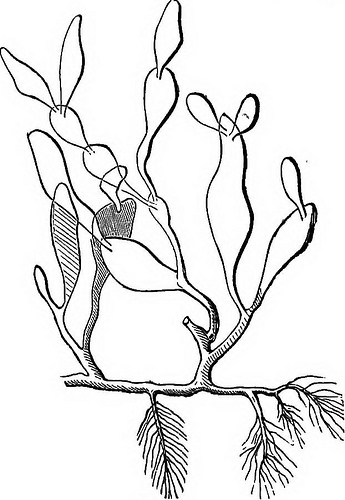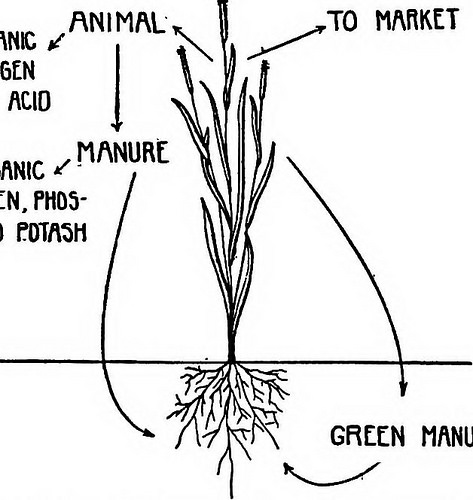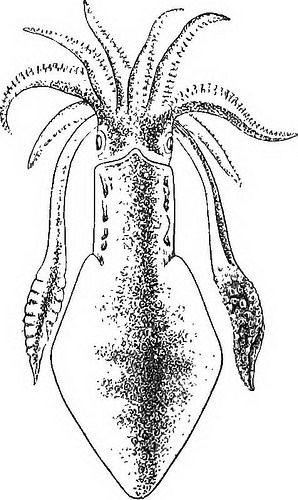Some cool pros and cons of organic food images:
Image from page 235 of “How crops grow. A treatise on the chemical composition, structure, and life of the plant, for all students of agriculture ..” (1868)

Image by Internet Archive Book Images
Identifier: cu31924000896575
Title: How crops grow. A treatise on the chemical composition, structure, and life of the plant, for all students of agriculture ..
Year: 1868 (1860s)
Authors: Johnson, Samuel William, 1830-1909
Subjects: Agricultural chemistry Growth (Plants)
Publisher: New York, O. Judd & company
Contributing Library: Cornell University Library
Digitizing Sponsor: MSN
View Book Page: Book Viewer
About This Book: Catalog Entry
View All Images: All Images From Book
Click here to view book online to see this illustration in context in a browseable online version of this book.
Text Appearing Before Image:
have vanished, while the cell-wall itselfhas thickened inwardly—the starch having been convei-t-ed into cellulose. Again, later, the nucleus, about which,in the meantime, m.ore starch-grains have been formed,imdergoes a change and disappears; then the starch-grains,some of which have enlarged while others have vanished,are found to be imbedded in a pasty matter, which has thereactions of an albuminoid. From this time on, the 230 HOW CEOPS GROW. starch-grains are gradually converted frorn their surfacesin-wardly into smaller grains of aleurone, which, finally,when the seed is mature, completely occupy the cells. In the sprouting of the seed similar changes occur, butin reversed order. The nucleus reappears, the aleurone dis-solves, and even the cellulose stratified upon the interiorof the cell, fig. 32, wastes away and is converted intosoluble food (sugar ?) for the seedling. The Dimensions of Vegetable Cells are very various.A creeping marine plant is known—^the CaulerpaproUfera,
Text Appearing After Image:
Fig. 33. fig. 33,—which consists of a single cell, though it is oftena foot in length, and is branched with what have the ap-pearance of leaves and roots. The pulp of the orange con-sists of cells which are one-quarter of an inch or more indiameter. Every fiber of cotton is a single cell. In most ELEMENTS OB ORGANIC STEUCTUBE, 231 cases, however, the cells of plants are so small as to re-quire a powerful microscope to distinguish them,—arc, infact, no more than l-1200th to l-200th of an inch In diam-eter ; many are vastly smaller. Growthi—^The growth of a plant is nothing more thanthe aggregate result of the enlargement and multiplicationof the cells which compose it. In most cases the cells at-tain their full size in a short time. The continuous growthof plants depends, then, chiefly on the constant and rapidformation of new cells. Cell-multiplicatioilt—The young and active cell alwayscontains a nucleus, (fig. 34, b.) Such a cell may producea new cell by division. In this pro
Note About Images
Please note that these images are extracted from scanned page images that may have been digitally enhanced for readability – coloration and appearance of these illustrations may not perfectly resemble the original work.
Image from page 296 of “Soils and fertilizers” (1918)

Image by Internet Archive Book Images
Identifier: cu31924073872842
Title: Soils and fertilizers
Year: 1918 (1910s)
Authors: Lyon, T. L. (Thomas Lyttleton), 1869-1938
Subjects: Soils Fertilizers Manures
Publisher: New York : Macmillan
Contributing Library: Cornell University Library
Digitizing Sponsor: MSN
View Book Page: Book Viewer
About This Book: Catalog Entry
View All Images: All Images From Book
Click here to view book online to see this illustration in context in a browseable online version of this book.
Text Appearing Before Image:
in a ton of the green crop, when in a con-dition to plow under, is as follows: Table 55. — Quantities of Nitrogen in Some LeguminousGreen-Manuke Crops Chop NitrogenPER Ton,Pounds PkobableYield pesAche, Tons 10 6 9 6 10 5 14 8 8 6 10 6 11 5 Nitrogen PEB Acre, PorHDB Red or mammoth cloverCrimson clover . . .Alsike clover …. Alfalfa Cowpeas Soy beans Canada field peas . . 605450112486055 GREEN-MANURES 237 Not all of the nitrogen contained in these crops is takenfrom the air. On soils rich in nitrogen, a considerable pro-portion may be obtained from the soil. On poor soils, theproportion derived from the atmosphere is considerablylarger. Soils needing nitrogen most are those that benefitmost largely from its application. 296. Transfer of plant-food materials. — There is a trans-fer of plant nutrients in a double sense: (1) removal of these LOaS lAfl6ELY OnSANIC / ^. WITH SOME N1TR06ENAND PHOSFHOniC ACID LARGE L035 Of OReANIC -^MATTER, NITROGEN, PHOS-PHORIC ACIO AND P0TA5H .TO MARKET
Text Appearing After Image:
GREEN MANURE Fia. 34. — Movements of plant-food materials. After absorption by theplant they may be returned in whole or in part to the soil. If grain andstraw or hay are sold nothing but the stubble and roots are returned. Iffad to animals, part may be returned in the manure. If plowed under asgreen-manure, all are returned. substances from combination with other minerals and theirconversion into combinations with organic matter; (2) re-moval from lower soil by absorption by roots and the deposi-tion of this material in the upper layer of soil when the plantdies and is plowed under. The first of these transfers resultsin an improved condition of the plant nutrients, because inthe combinations with organic matter they are in generalmore available to plants than when in combinations with 238 SOILS AND FERTILIZERS inorganic matter. By the second form of transfer the nutri-ents in this available form are deposited in the upper soil fromwhich most crops draw the larger part of their nut
Note About Images
Please note that these images are extracted from scanned page images that may have been digitally enhanced for readability – coloration and appearance of these illustrations may not perfectly resemble the original work.
Image from page 429 of “Outlines of zoology” (1916)

Image by Internet Archive Book Images
Identifier: cu31924003404161
Title: Outlines of zoology
Year: 1916 (1910s)
Authors: Thomson, J. Arthur (John Arthur), 1861-1933
Subjects: Zoology
Publisher: New York, Appleton
Contributing Library: Cornell University Library
Digitizing Sponsor: MSN
View Book Page: Book Viewer
About This Book: Catalog Entry
View All Images: All Images From Book
Click here to view book online to see this illustration in context in a browseable online version of this book.
Text Appearing Before Image:
ich ingiant cuttlefish is dangerouseven to men. The inneredge of the cup margin issupported by a chitinoidring bearing small teeth.Each cup acts as a sucker,in a fashion which hasmany analogues, for aretractor muscle increasesthe size of the cavityafter the margin has beenapplied to some object.The external pressure isthen greater than thatwithin the cup, and thelittle teeth keep the attach-ment from slipping. It seems likely that thearms represent a pro-podium, and the siphona mesopodium, and avalve within the siphonhas been compared to ametapodium. Skeletal system.—An internal skeleton is represented bysupporting cartilaginous plates in various parts of the body,especially—(a) in the head, round about the brain, archingover the eyes, enclosing the ears ; {b) at the bases of thearms; (c) as a crescent on the neck; {i) at the hook-and-eye arrangement of the mantle flap; (e) along the fringingfins. Ramified stellate cells lie in the structurelesstransparent matrix of the cartilage.
Text Appearing After Image:
Fig. 217.—External appearance ofa cuttlefish {Loligo). NERVOUS SYSTEM. 405 On the shore one often finds the cuttle bone or sepio-staire, which is sometimes given to cage birds to peck atfor lime, or used for polishing and other purposes. It lieson the dorsal side of the animal, covered over by the mantlesac. In outline it is somewhat ellipsoidal, thinned at theedges like a flint axe-head, and with curved markings whichindicate lines of growth. In the very young Sepia it con-sists wholly of the organic basis conchiolin, but to this limeis added from the walls of the sac. Between the platesof lime there is gas, and though the structure may givethe cuttle some stability, it is probably of more use as afloat. Internal appearance.—When the mantle flap is cut openand reflected, the two plume-like gills are seen, and thelower end of the siphon. The dark outline of the ink-bag,followed along towards the head, leads our eyes to the endof the food canal. Near this are the external apertures
Note About Images
Please note that these images are extracted from scanned page images that may have been digitally enhanced for readability – coloration and appearance of these illustrations may not perfectly resemble the original work.
